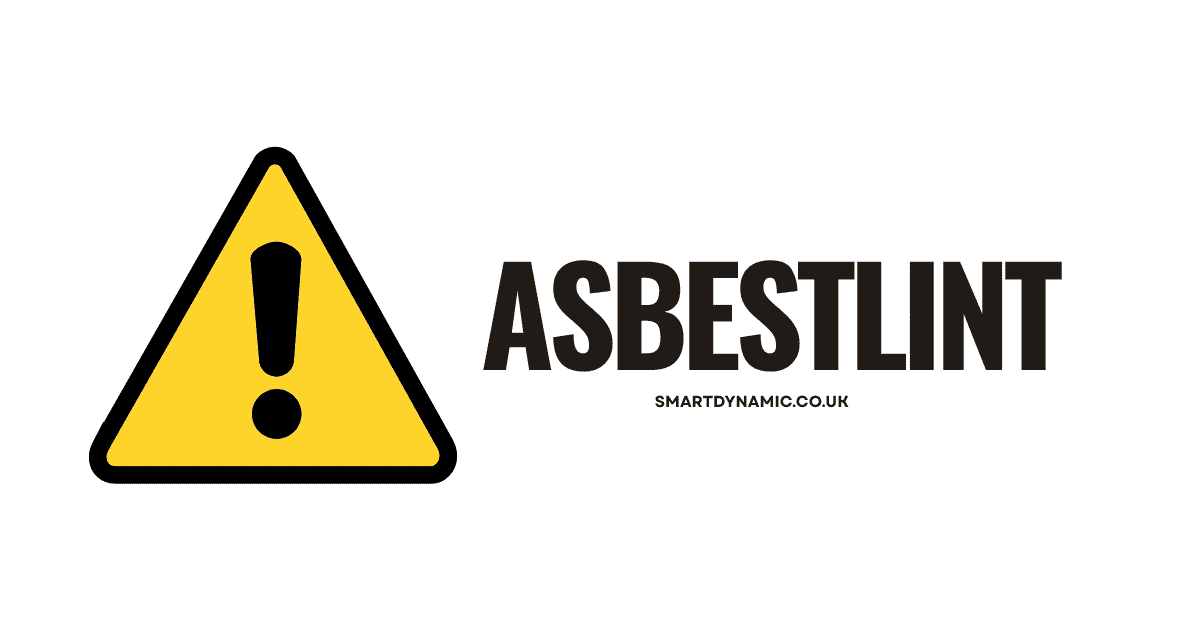Introduction
Asbestlint is a deceptive and highly hazardous material consisting of clumped or loose asbestos fibers that resemble dust or fabric lint. This substance is released when asbestos-containing materials (ACMs) degrade, are damaged, or are disturbed during renovations. The danger lies in its microscopic, airborne fibers, which, when inhaled, can lodge deep in the lungs and cause irreversible, life-threatening diseases like asbestosis, lung cancer, and mesothelioma. These illnesses often have a long latency period, developing decades after exposure. This comprehensive guide will walk you through the critical steps of understanding asbestlint, identifying its potential sources, recognizing the severe health implications, and implementing safe handling, removal, and disposal procedures. Your safety and knowledge are the first line of defense against this silent hazard.
What is Asbestlint?
Asbestlint is not a scientific term but a practical, descriptive one used to refer to the fibrous, dust-like release of asbestos. Unlike intact, non-friable asbestos products (like vinyl floor tiles), asbestlint represents a friable state—meaning the material can be easily crumbled by hand pressure, releasing fibers into the air. It often appears as a greyish-white, fluffy, or clumpy debris, similar to household dust or insulation lint, but is infinitely more dangerous.
This hazardous substance originates from the breakdown of asbestos-containing materials, which were widely used in construction and industry throughout the 20th century for their heat resistance, strength, and insulating properties. Common sources include:
-
Aging Thermal Insulation: On pipes, boilers, and furnaces.
-
Damaged Textiles: Such as asbestos cloth, fire blankets, or old heater wall gaskets.
-
Deteriorating Spray-on Coatings: On ceilings and steelwork.
-
Worn-out Acoustic Insulation.
Understanding that this seemingly innocuous “lint” can be a potent carcinogen is the first step in mitigating risk.
Health Risks — Why Asbestlint is Dangerous
The peril of asbestlint is directly tied to the nature of asbestos fibers. When disturbed, these microscopic, needle-like fibers become airborne and are easily inhaled. Once in the lungs, the body struggles to expel them, leading to scarring, inflammation, and genetic damage over time. This can result in several devastating diseases:
-
Asbestosis: A progressive, long-term non-cancerous disease of the lungs caused by the inhalation of asbestos fibers. It leads to scarring (fibrosis) of lung tissue, causing shortness of breath, a persistent cough, and permanent lung damage.
-
Mesothelioma: A rare and aggressive form of cancer that primarily affects the lining of the lungs (pleura) or the abdomen (peritoneum). It is almost exclusively caused by asbestos exposure.
-
Lung Cancer: Asbestos exposure significantly increases the risk of developing lung cancer, with the risk magnified in smokers.
A critical aspect of these diseases is their long latency period. Symptoms may not appear for 20 to 50 years after the initial exposure. There is no safe level of exposure; even short-term, intense exposure or low-level, repeated exposure can be hazardous. Vulnerable groups include construction workers, DIY renovators, firefighters, and even family members of workers who may have brought asbestos dust home on their clothing. The World Health Organization (WHO) states that all types of asbestos are carcinogenic to humans.
Where Asbestlint Is Found
Asbestlint typically forms where asbestos-containing materials are subject to friction, aging, or damage. In domestic and commercial settings, you might encounter it in:
-
Older Homes and Workshops (built before the 1980s): This is the most common location.
-
Around Pipe and Boiler Insulation: As the insulation degrades, it can shed fibrous asbestlint.
-
Inside or Around Old Heating Systems: Such as decaying ductwork tape or furnace insulation.
-
Attics with Vermiculite Insulation: Some vermiculite was contaminated with asbestos.
-
On Damaged Ceiling Tiles or Spray-on “Popcorn” Ceilings.
-
From Worn-Out Gaskets in old appliances, stoves, and pipe connections.
-
During Renovation Debris: When cutting, sanding, or breaking apart ACMs.
Real-life example: A homeowner sanding down an old wall around a wood-burning stove may unknowingly create a cloud of asbestlint from the deteriorating asbestos gasket material, contaminating the entire room.
How to Identify Suspected Asbestlint
You cannot identify asbestos by sight or smell alone. Laboratory analysis is the only definitive method. However, you can develop a strong suspicion based on several factors:
-
Visual Clues: Look for a greyish, white, or bluish fibrous material that resembles fluffy dust or matted lint, often found near old insulation or heating systems.
-
Building Age: If your home or building was constructed or renovated before 1980, there is a high probability that asbestos-containing materials were used.
-
Material Type: Be suspicious of loose-fill, spray-on, or soft, fibrous insulation materials.
A Checklist for Suspicion:
-
Is the material fibrous and easily crumbled?
-
Is it located on a hot pipe, boiler, or furnace?
-
Was the building constructed pre-1980?
-
Is the material damaged, frayed, or deteriorating?
Crucial Warning: Do not rely on visual identification. If you have any suspicion, the safest course of action is to treat the material as if it contains asbestos until proven otherwise.
Testing & Professional Assessment
If you suspect asbestlint, the next step is professional testing. A certified asbestos inspector will conduct a safe assessment.
How it Works:
-
Visual Inspection: The inspector will identify potential ACMs.
-
Safe Sample Collection: Wearing personal protective equipment (PPE), they will lightly wet the material to suppress fibers, carefully collect a small sample using specialized tools, and seal it in a clean container.
-
Lab Analysis: The sample is sent to an accredited laboratory for analysis, typically using Polarized Light Microscopy (PLM) or Transmission Electron Microscopy (TEM) to identify the type and concentration of asbestos fibers.
Why DIY Testing is Extremely Risky:
DIY test kits are available, but collecting the sample yourself is the most dangerous part of the process. Disturbing the material without proper containment, PPE, or technique can release a significant cloud of hazardous fibers into your home, putting you and your family at risk. The EPA strongly recommends using a trained and accredited asbestos professional for sampling.
Immediate Steps If You Suspect Asbestlint
If you discover what you believe to be asbestlint, do not panic. Follow these steps immediately to minimize exposure:
-
DO NOT DISTURB: Do not touch, sweep, vacuum, or blow on the material. Vacuuming, even with a HEPA vacuum, can initially disturb and spread fibers unless done by a professional.
-
ISOLATE THE AREA: Restrict access to the room or space. Close the door and seal the bottom with tape if possible.
-
STOP AIRFLOW: Turn off any central heating, air conditioning, or fans to prevent the circulation of airborne fibers.
-
AVOID CREATING DUST: Do not dust or sweep any surfaces in the contaminated area.
-
CALL A LICENSED PROFESSIONAL: Contact a state-licensed asbestos abatement contractor for an immediate assessment. This is not a job for a general handyman.
Safe Removal, Abatement & Disposal
The safe removal of asbestos-containing materials, including asbestlint, is a highly regulated process known as asbestos abatement. It must only be performed by licensed professionals.
Licensed Removal Process:
-
Containment: The work area is sealed with plastic sheeting to create a negative air pressure enclosure, preventing fibers from escaping.
-
Personal Protective Equipment (PPE): Workers wear respirators and disposable coveralls.
-
Wet Methods: The material is thoroughly wetted down with amended water to suppress dust and fibers.
-
Careful Removal: The asbestlint and contaminated materials are carefully removed and placed in leak-tight, labeled containers.
-
HEPA Filtration: Air scrubbers with HEPA filters run continuously to clean the air inside the containment.
-
Thorough Cleaning: All surfaces are wet-wiped and HEPA-vacuumed.
Encapsulation vs. Removal:
Sometimes, if the material is in good condition and unlikely to be disturbed, encapsulation (sealing it with a special coating) is a safer and cheaper alternative to full removal. A professional can advise on the best course.
Disposal Regulations:
Asbestos waste is classified as hazardous and must be disposed of at a licensed landfill that accepts it. Improper disposal is illegal and carries heavy fines.
Regulations & Standards
Various agencies have established strict regulations to protect people from asbestos exposure:
-
EPA (Environmental Protection Agency): The EPA’s Asbestos National Emission Standards for Hazardous Air Pollutants (NESHAP) regulates the demolition and renovation of buildings containing asbestos.
-
OSHA (Occupational Safety and Health Administration): Sets permissible exposure limits and mandates safety practices for workers in general industry and construction. OSHA’s Asbestos Standards are critical for workplace safety.
-
EU ECHA (European Chemicals Agency): Manages the Registration, Evaluation, Authorisation and Restriction of Chemicals (REACH) regulations, which heavily restrict asbestos use in Europe.
Property owners and landlords have a legal responsibility to manage asbestos in their buildings and disclose its presence to tenants and buyers.
Prevention & Retrofit
The best way to prevent exposure to asbestlint is through proactive management.
-
Pre-Renovation Survey: Before ANY renovation or demolition activity on a pre-1980s building, hire a qualified inspector to conduct an asbestos inspection.
-
Safe Renovation Practices: Assume materials contain asbestos until proven otherwise. Avoid drilling, sawing, or sanding into suspect materials.
-
Regular Monitoring: If you have known, undamaged ACMs in your home, monitor their condition periodically for signs of damage or deterioration.
Alternatives & Safe Product Options
Modern technology provides excellent, safer alternatives to asbestos:
-
Fire-Resistant Insulation: Mineral wool, fiberglass, and cellulose are all effective and safe alternatives for thermal insulation.
-
Gaskets and Textiles: Aramid fibers (e.g., Kevlar), carbon fiber, and graphite-based materials are used for high-temperature gaskets and seals.
-
Building Materials: Non-asbestos cement boards, coatings, and tiles are now standard.
Myths & Misconceptions
-
Myth: “Asbestos is banned, so my home is safe.”
Fact: Many older homes still contain asbestos. Its use was heavily restricted, not fully banned, in many countries, and existing materials were often left in place. -
Myth: “One-time, short-term exposure is harmless.”
Fact: There is no known safe level of exposure. Any exposure carries some risk. -
Myth: “If I wear a dust mask, I can remove it myself.”
Fact: Standard dust masks are useless against microscopic asbestos fibers. Abatement requires fitted respirators and full containment.
FAQs
1. What’s the difference between asbestos lint and asbestos dust?
They are often used interchangeably. “Lint” implies a more fibrous, clumped texture, while “dust” is finer, but both refer to friable, releasable asbestos fibers and are equally dangerous.
2. Can I remove asbestlint myself?
No. DIY removal is extremely hazardous and illegal for certain types and amounts of material in many jurisdictions due to the high risk of uncontrolled fiber release.
3. How long after exposure do diseases appear?
Diseases like mesothelioma and asbestosis have a long latency period of 20 to 50 years.
4. Who is responsible for paying for asbestos removal?
Typically, the property owner is responsible. In rental properties, laws vary, but landlords are generally responsible for maintaining a safe environment.
5. Is it safe to live in a house with non-friable asbestos?
Yes, if the material is in good condition, sealed, and left completely undisturbed. The danger arises when it is damaged or disturbed during work.
6. What should I do if I’ve already been exposed?
Inform your doctor about the potential exposure, even if it was years ago. They can monitor your lung health and be aware of early symptoms.
7. Can you see asbestos fibers?
Individual asbestos fibers are microscopic. What you see as “lint” or “dust” are clumps of millions of fibers.
8. Does homeowners insurance cover asbestos removal?
It depends on your policy and the cause of the disturbance. Most standard policies exclude pollution-related cleanups like asbestos. You must check with your insurer.
Conclusion & Call to Action
Asbestlint is a hidden and severe health hazard that should never be underestimated. Its ability to cause devastating, incurable diseases decades after exposure makes proactive management and professional intervention non-negotiable. Do not let its innocuous appearance deceive you. If you live or work in an older building and suspect the presence of this hazardous material, your immediate action should be to stop, isolate the area, and contact a licensed asbestos professional for testing and safe abatement. Your health and the health of your family are worth the investment in expert, safe handling.
Author Info
Johnathan R. Clarke is a Certified Industrial Hygienist (CIH) with over 20 years of experience in occupational and environmental health and safety. He specializes in hazardous material assessment, including asbestos, lead, and mold, and has contributed to developing industry safety protocols. His writing is dedicated to translating complex environmental hazards into actionable, life-saving information for the public.
Last Updated: October 26, 2023








One thought on “Asbestlint: Risks, Identification, Safe Handling & Removal”